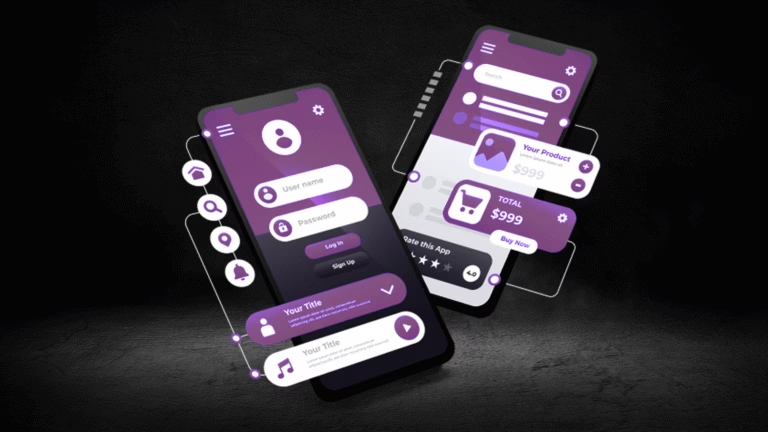
Introduction to Web and App Development
The rapid expansion of digital technologies has given rise to distinctive roles that shape our online experiences. Within this evolving landscape, the terms web developer, web designer, and app developer have become increasingly prominent, each representing crucial aspects of technology and design. Understanding the differences between these professions is vital for anyone looking to navigate the technology sector or pursue a career in digital development.
Web development primarily focuses on the backend and frontend processes that drive websites. A web developer is responsible for building and maintaining the functionality of websites, using programming languages such as HTML, CSS, and JavaScript. This role demands a strong understanding of both technical and user experience elements to ensure smooth interaction between the server and the user interface.
In contrast, web design emphasizes the aesthetic and functional aspects of online platforms. A web designer’s role is to create visually appealing layouts and engaging user interfaces that enhance the user experience. This profession involves a blend of creativity and technical knowledge, often using design software to prototype and iterate ideas before handing them off to web developers for implementation.
App development, on the other hand, is focused on creating software applications for mobile or desktop environments. An app developer works on the design, architecture, and coding of applications, ensuring that they operate effectively across various devices and platforms. This role typically requires proficiency in languages specific to app development, such as Swift for iOS and Kotlin for Android, and emphasizes the need for seamless functionality and user engagement.
As digital platforms continue to proliferate, the significance of web developers, web designers, and app developers will only grow. Each role complements the others, contributing to the rich fabric of technology that shapes how we interact with the online world today. Understanding these distinctions not only aids in recognizing career paths but also underscores the importance of collaboration among these professionals in delivering comprehensive digital solutions.
Understanding Web Development
Web development encompasses a range of activities and technologies that play a crucial role in building and maintaining websites and web applications. At its core, web development is divided into two primary segments: front-end development and back-end development. Each segment requires distinct skills and knowledge, as web developers must navigate various technologies to create functional and visually appealing interfaces.
Front-end developers focus on the aspects of a website that users interact with directly. They utilize languages such as HTML, CSS, and JavaScript to create visually engaging and responsive designs. HTML serves as the foundation, structuring the content of web pages. CSS enhances the appearance, allowing developers to apply styles, create layouts, and manage responsive designs across devices. JavaScript, as a high-level programming language, empowers these developers to implement interactive features, improving the user’s experience. The synergy between these technologies enables web developers to construct an intuitive and aesthetically pleasing environment for users.
On the other hand, back-end development deals with the server side of web applications. This involves managing databases, server configurations, and application logic. Back-end developers commonly work with programming languages such as PHP, Python, Ruby, and Java, alongside frameworks tailored for each language. They ensure data flows correctly between the server, database, and front-end interface, thereby creating a seamless user experience. By managing data storage and retrieval, back-end development provides the necessary infrastructure that supports web applications.
Ultimately, web developers play an integral role in constructing the backbone of websites and web applications. Their expertise and proficiency in both front-end and back-end technologies allow them to build cohesive digital experiences, bridging the gap between functionality and design. As the digital landscape evolves, the demand for skilled web developers continues to grow, furthering the need for individuals to understand this multifaceted profession.
The Role of Web Designers
Web designers play a crucial role in the digital landscape by focusing on the visual aesthetics and usability aspects of websites. Their primary responsibility is to create appealing and user-friendly interfaces that enhance the overall user experience (UX). To achieve this, web designers employ various design principles such as balance, contrast, alignment, and hierarchy. These principles guide the arrangement of elements on a webpage, ensuring that users can navigate effortlessly and engage with the content presented.
In the realm of UX design, web designers strive to understand the needs and behaviors of users. They conduct research and gather insights to inform their design choices, ensuring that the final product is not only attractive but also functional and intuitive. User interface (UI) design is another vital aspect of a web designer’s role, where they focus on creating visually interactive elements, such as buttons, icons, and menus, that contribute to a cohesive user journey.
To create effective designs, web designers often utilize specialized tools that streamline their workflow. Software such as Adobe XD and Figma enables designers to prototype and collaborate efficiently, allowing for real-time feedback and adjustments. These tools also facilitate the process of creating responsive designs that adapt seamlessly to various devices, from desktops to mobile screens.
The importance of aesthetics in web design cannot be overstated. A visually appealing website not only attracts visitors but also builds credibility and fosters trust. Usability is equally significant; a well-designed website will engage users and encourage them to explore further. Therefore, web designers work closely with developers to ensure that their creative visions are accurately translated into functional websites. This collaboration is essential, as it bridges the gap between design and technology, resulting in an engaging user experience that meets both aesthetic and functional requirements.
App Development Explained
App development encompasses a variety of processes that involve creating software applications for mobile devices, web browsers, or both. Unlike web design, which focuses on the aesthetic and user experience aspects of websites, the role of an app developer involves specialized programming skills to build applications that are functional and efficient. Apps can be divided into two main categories: mobile apps and web apps, each having distinct characteristics and requirements.
Mobile app development primarily targets platforms such as iOS and Android. Each platform utilizes different programming languages and frameworks; for instance, iOS applications are commonly developed using Swift or Objective-C, while Android applications typically employ Kotlin or Java. These languages are essential for creating responsive and user-friendly applications that can seamlessly interact with various hardware and software components on mobile devices.
Conversely, web app development focuses on applications accessible through web browsers rather than being installed on a device. Web developers often utilize languages such as JavaScript, HTML, and CSS, along with frameworks like React or Angular, to create dynamic web applications that function similarly to native mobile apps.
Each type of app development presents unique challenges. Mobile app developers must navigate differences in operating system guidelines, performance optimization for varying devices, and user interface compliance across diverse screen sizes. On the other hand, web app developers deal with browser compatibility issues and need to ensure security and data privacy through their applications.
In conclusion, understanding the nuanced roles of app developers, including the contrast between mobile and web app development, is crucial for anyone looking to delve into the world of technology. The proficiency in collaborating with multiple platforms and programming languages is paramount for success in the app development field.
Comparison of Web Developer, Web Designer, and App Developer
When exploring the digital landscape, it is important to understand the distinct roles of a web developer, a web designer, and an app developer. Each of these crucial roles contributes to the creation of functional and visually appealing digital products, yet they have unique responsibilities and skill sets.
A web developer is primarily responsible for building and maintaining websites. Their work focuses on coding and programming, which requires proficiency in languages such as HTML, CSS, JavaScript, and backend technologies like PHP and Python. They ensure that websites function smoothly, employing various tools like Git for version control and frameworks such as React or Angular to enhance web applications. Generally, a formal education in computer science or a related field is common among web developers, though many have self-taught skills or completed boot camps.
Conversely, a web designer centers their work on the visual aspects of a website. This role involves creating user-friendly interfaces and designing layouts that are aesthetically pleasing. Tools like Adobe Photoshop, Sketch, and Figma are commonly used by web designers to devise graphics and prototypes. A solid understanding of graphic design principles and human-computer interaction remains essential for a web designer’s success. While formal education in design or a related field can be advantageous, many web designers build their portfolios through self-directed projects and may pursue online certifications.
The role of an app developer diverges further, focusing primarily on creating applications for mobile or desktop platforms. App developers often specialize in either iOS or Android development, utilizing languages such as Swift and Java. Their work involves not only coding but also understanding user experiences and testing applications for functionality and usability. Similar to web developers and designers, a background in computer science or a related discipline is advantageous, but self-learning and practical experience are also common pathways to entering this field.
Educational Paths and Skill Development
The journey towards becoming a web developer, web designer, or app developer can take various forms, influenced heavily by one’s career aspirations, resources, and learning preferences. Traditionally, many individuals enter these fields through formal education. Pursuing a degree in computer science, software engineering, or graphic design can provide foundational knowledge and technical skills that are beneficial for anyone looking to carve a niche in the tech industry. These programs often cover essential topics, such as programming languages, user interface design, and application development, providing students with a comprehensive understanding of both theory and practice.
On the other hand, the tech landscape has evolved to accommodate various learning styles, leading to the rise of self-taught routes. Numerous online platforms, such as Codecademy, Coursera, and Udacity, offer courses catered to aspiring web developers and designers, allowing individuals to learn at their own pace. Bootcamps have also gained popularity, providing intensive, short-term programs that cover the essentials of coding and design in a matter of weeks. Such programs often emphasize hands-on projects, preparing learners for real-world scenarios and enabling them to build a strong portfolio, which is critical when competing for jobs in these fields.
Regardless of the path chosen, continuous skill development is paramount. The tech industry is characterized by rapid advancements, with new frameworks, languages, and design trends emerging regularly. Therefore, it is crucial for web developers, web designers, and app developers to remain adaptable and invest time in learning new tools and technologies. Networking events, online forums, and workshops can also serve as valuable resources for professional growth, allowing individuals to collaborate and share knowledge. By embracing both formal education and self-directed learning, aspiring professionals can equip themselves with the necessary skills to thrive in an ever-evolving digital landscape.
Job Market and Career Opportunities
The job market for web developers, web designers, and app developers has grown significantly in recent years, driven by an increased reliance on technology across various industries. With the ongoing digital transformation, companies are actively seeking professionals who can create and maintain their online presence or develop innovative apps tailored to consumer needs. This burgeoning demand reflects a trend of businesses adapting to new digital paradigms, thereby creating numerous employment opportunities.
Web developers, in particular, are in high demand, as they are crucial for building functional and visually appealing websites. Their expertise ranges from coding to user experience design, making them essential for companies looking to enhance their digital footprint. According to recent data, web developers can expect competitive salaries, often starting from entry-level ranges and exceeding six figures as they gain experience and expertise. Additionally, the role of a web developer offers the potential for significant career growth, with opportunities to specialize in areas such as front-end or back-end development, or even transitioning into related fields like project management or UX design.
Web designers also enjoy promising career opportunities, although their role often involves a more creative focus compared to web developers. The current job market shows increasing appreciation for designers who can effortlessly blend aesthetics with functionality. Designers skilled in responsive design, mobile usability, and user interface design are particularly sought after. Salary expectations can vary widely based on experience and location, but many designers find lucrative opportunities within agencies or as freelancers. The balance of creative expression and technical skill makes web design a compelling field for those considering this career path.
App developers, meanwhile, are experiencing a rise in demand paralleling the increasing use of mobile devices. Organizations require skilled app developers to create applications that engage users and align with their business strategies. The prospects for app developers are equally bright, with salary ranges often reflective of the technical expertise and niche skills required for mobile development. Remote work has become a prevalent option in this field, allowing app developers flexibility while maintaining a healthy work-life balance. As the tech industry continues to evolve, the need for qualified professionals in these roles is expected to persist.
Working Collaboratively: The Tech Team
In the dynamic landscape of technology, the collaboration between web developers, web designers, and app developers is critical for delivering cohesive products. Although their roles differ significantly, each contributes a unique skill set that enhances the overall functionality and aesthetics of digital projects. Understanding how these professionals interact and the importance of effective communication is essential for successful project completion.
Web developers primarily focus on the coding and technical aspects of websites and applications. They ensure that the functionality and performance meet the necessary standards. Conversely, web designers are tasked with creating the visual elements and user interface that make digital products not only functional but also engaging. App developers, on the other hand, specialize in mobile applications and often collaborate with both web developers and web designers to ensure that the end product is optimized for mobile devices. This synergy is vital; when these roles understand each other’s strengths and challenges, they can better complement each other’s work.
Effective communication is fundamental in a tech team. Regular meetings, updates, and the use of collaboration tools can help bridge any gaps between different roles. It is essential that web developers articulate their technical requirements clearly, while web designers must communicate their visual concepts effectively. Similarly, app developers need to share insights about mobile trends and user preferences. By prioritizing communication, the tech team can foster an environment where insights and feedback are exchanged freely, enhancing the project’s overall quality.
When web developers, web designers, and app developers collaboratively engage in their tasks, they are more likely to produce cohesive, user-friendly products that stand up to the demands of today’s technology-driven market. A well-coordinated team can unleash the full potential of their respective expertise, resulting in an exemplary user experience that aligns with stakeholder objectives.
Future Trends in Web and App Development
The field of web and app development is continuously evolving, driven by advancements in technology and changing user expectations. As a result, both web developers and web designers must stay informed about emerging trends to remain competitive and relevant in their respective disciplines. One significant trend shaping the future is the rise of progressive web apps (PWAs). PWAs combine the best of web and mobile applications, providing a seamless user experience that works across different devices and platforms without the need for separate codebases. This approach enables developers to create robust applications that offer offline capabilities, faster load times, and enhanced performance.
Another essential trend is the emphasis on responsive design. With the increasing variety of devices used to access the internet, it has become critical for web developers to create websites that adapt to various screen sizes and resolutions. Responsive web design ensures a consistent user experience, improving user engagement and retention, which is vital for both web sites and applications.
Artificial intelligence (AI) integration is also on the rise in web and app development. AI serves various purposes, such as enhancing user interfaces, personalizing experiences, and automating repetitive tasks. Developers are leveraging AI-driven tools to streamline their workflows, improve code quality, and enhance testing processes, enabling faster project completion and greater innovation. Furthermore, accessibility is becoming more imperative in development practices as professionals in the industry prioritize inclusivity. Ensuring that web and app applications cater to users with disabilities is not only a legal requirement in many regions but also a significant part of ethical design.
As we look toward the future, the skills associated with these trends will become increasingly valuable for web developers, web designers, and app developers. Embracing these developments and continuing to adapt will be essential for success in an ever-evolving digital landscape.
Conclusion: Choosing the Right Path for You
When contemplating a career in the tech industry, it becomes essential to understand the distinctions between the roles of a web developer, web designer, and app developer. Each position holds unique responsibilities and requires specific skill sets that cater to different interests and strengths. A web developer is primarily focused on coding and building the functionality of websites, which involves proficiency in programming languages, backend development, and server management. In contrast, a web designer emphasizes aesthetics, ensuring that the site is visually appealing and user-friendly through design principles and tools. App developers, on the other hand, specialize in creating mobile or desktop applications, requiring an understanding of user experience and software development practices.
As you weigh the options between these diverse roles, consider what aspects of technology excite you the most. If you enjoy problem-solving and building systems, a career as a web developer might be the most fulfilling for you. If creativity and user interaction captivate your interest, pursuing a path as a web designer could align perfectly with your aspirations. Meanwhile, if you are drawn towards mobile technology and creating tools for users’ daily lives, working as an app developer would be a significant choice.
Moreover, all three roles offer considerable career growth and stability in a rapidly evolving industry. Each profession not only contributes to the digital landscape but also allows professionals to evolve alongside technological advancements. Ultimately, choosing the right path is about aligning your personal interests and strengths with the demands of the role. Whether you see yourself enhancing websites, crafting beautiful designs, or developing innovative applications, the tech industry offers a wealth of opportunities for those willing to embark on this journey.








